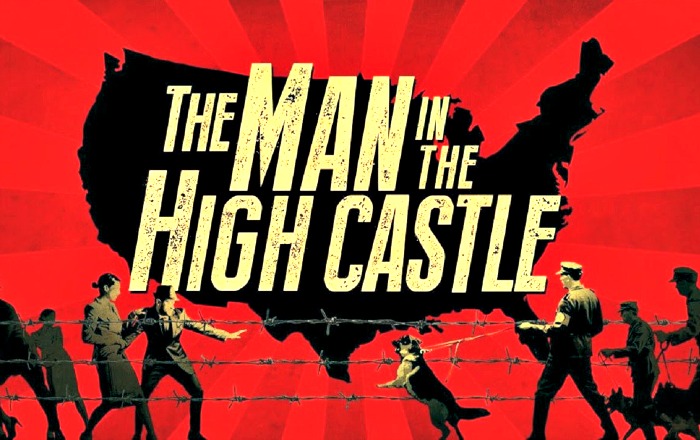

Amazon Studio’s TV series, “The Man in the High Castle,” opens with quintessential images of American symbols of pride: the beautiful skyline of New York City, the Golden Gate Bridge and a statue of an eagle, poised to fly. You can almost hear such symbols saying “God Bless Our Homeland,” yet these images quickly become warped. Over the New York skyline quivers the projection of a swastika. A radiant red sun with rays spreading down, overtakes the Golden Gate Bridge to evoke Japanese imperial imposition in America. Even the eagle, ruffled to show its bald head, fades in comparison to the imposed Nazi eagle. The nation’s prideful symbols become covered with shame. The soft, mournful tune of “Edelweiss” plays as the images change. “Bless my homeland forever,” we hear, only to see the national blessings linked with these images betrayed.
“The Man in the High Castle” transports 21st-century viewers to a dystopian alternate universe in 1962, in which the Axis Powers won World War II and took over the United States, with the Nazi Reich overpowering the East Coast, Imperial Japan grasping the West Coast and the Rocky Mountains serving as a pseudo-lawless Neutral Zone. The story follows a wide variety of characters involved with a resistance group that is trying to smuggle films called “The Grasshopper Lies Heavy” across the two empires to a mysterious man only known as the "Man in the High Castle.”
The story begins with Juliana Crain (Alexa Davalos), a young woman living in San Francisco, who is given the film by her deceased, Resistance-affiliated sister with instructions to get it to the "Man in the High Castle.” Meanwhile, Joe Blake (Luke Kleintank), a young upstart in New York City, drives an array of packages to the Neutral Zone for the Resistance. Juliana chooses to watch the film before embarking on this journey and watches an alternate history: a series of images of the U.S. and Soviet Union taking over the ruins of Berlin and ending the war. The series follows these two, as well as a huge cast of supporting characters such as Frank Fink (Rupert Evans), Juliana’s boyfriend of Jewish ancestry who is simply trying to remain alive and the Obergruppenführer John Smith (Rufus Sewell), a loving family man and ruthless officer who is hell-bent on finding these films. The sections involving the old and powerful characters associated with the imperial regimes are filled with attention-grabbing nuances, and they may deserve even more screen time than the sections involved with the Resistance.
With such controversial material, a lot could go wrong. And some things do go wrong: One of the show’s marketing campaigns included the flag of the Greater Nazi Reich, on which a swastika was placed in the corner. These flags were plastered on the seats of New York City subway system — a region with a large Jewish community. Not a good move.
With that in mind, I was prepared to despise the series for dealing with such material insensitively. I was expecting a certain, typical American jingoistic story that would bolster a sense of nationalism and exceptionalism. What I found was something so much more complex, interesting and mind-blowing that I wound up binging through the series during Thanksgiving break. The series deals with the plights of the oppressed characters and their vigilance against the oppressors, while also focusing on the other side of the story and how powerful characters deal with the troubles of working within a fascist state. In one scene, Obergruppenfuhrer John Smith sits at the breakfast table with his family. The only thing out of place in this image is the red swastika arm band that he is wearing.
The series constantly juxtaposes commonplace, happy American scenes of laughing children, smiling wives and proud young soldiers with harmful images like the swastika arm band to show how the joyful lives of some characters are intertwined with something so averse to our modern sensibility.
This creates an incredibly tense experience throughout the 10-episode first season. The series never stops jarring the viewer, moving at a steady slow burn, the action is a sure juggernaut of tense emotion, frustration and shock. It is not an easy viewing; I found myself screaming at the screen on more than one occasion, tearing up at others and having to pause the action in order to fully comprehend some of the events. Some scenes forced me to think deeply about what it’s like to watch this TV series from my modern point of view and to wonder why this series was made now, in 2015. Perhaps it’s in light of many people’s fear that America is currently losing its identity, xenophobia, trust in the government or the nation’s controversial path to success. Or perhaps it’s about how easy it is to justify horrible, inhumane actions with supposedly just causes, or how easy it would be to accept this world as decent and continue to impose its rules and terrors.
At one point, Joe Blake’s truck pops a tire on the road to the Neutral Zone. A cheery fat police officer, chuckling and joking — a classic image of American traditionalism — rolls over to help him out. A small storm of ash starts falling from the sky like clumps of snow. Upon seeing Blake’s confused expression, the officer says, “Oh, it’s the hospital. It’s Wednesday, they’re burning the cripples.” And he goes back to fixing the tire.
The 10 episodes of the first season of “The Man in the High Castle” can now be streamed on Amazon Prime, and I highly recommend it as an artistic analysis of both the past and present state of the questionable social and political systems, particularly in America.